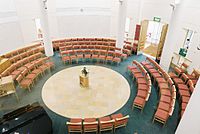| Revision as of 21:45, 18 July 2008 editAnnaFrance (talk | contribs)6,815 editsm Disambig page style repair: (you can help!) using AWB← Previous edit | Revision as of 01:21, 13 August 2008 edit undoDrunken Pirate (talk | contribs)4,396 editsm Robot-assisted disambiguation: Air raid - Changed link(s) to airstrikeNext edit → | ||
| Line 7: | Line 7: | ||
| ==The Chapel== | ==The Chapel== | ||
| The building was renamed the '''Cross Street Chapel''' and became a Unitarian meeting-house c.1761.<ref>Shercliff WH. ''Manchester: A Short History of its Development'', Municipal Information Bureau, Town Hall, Manchester (1960)</ref> It was wrecked by a ] mob in ], rebuilt and destroyed in a ] ] in December ]. A new building was constructed in ] and the present structure dates from ]. | The building was renamed the '''Cross Street Chapel''' and became a Unitarian meeting-house c.1761.<ref>Shercliff WH. ''Manchester: A Short History of its Development'', Municipal Information Bureau, Town Hall, Manchester (1960)</ref> It was wrecked by a ] mob in ], rebuilt and destroyed in a ] ] in December ]. A new building was constructed in ] and the present structure dates from ]. | ||
| The ''Gaskell Room'' of the new building houses a collection of memorabilia of ] ]. | The ''Gaskell Room'' of the new building houses a collection of memorabilia of ] ]. | ||
Revision as of 01:21, 13 August 2008

Cross Street Chapel is a Unitarian church in Manchester, England, famous in civic and national life for its contributions to piety and civil society.
History

The Act of Uniformity 1662, regulated the style of worship in the Church of England. However, many clergy rejected the restrictions, including Rev. Henry Newcome who established his own congregation that same year. The Dissenters' Meeting House was opened in 1694 and holds a special place in the growth of nonconformism within the city.
The Chapel
The building was renamed the Cross Street Chapel and became a Unitarian meeting-house c.1761. It was wrecked by a Jacobite mob in 1715, rebuilt and destroyed in a World War II air raid in December 1940. A new building was constructed in 1959 and the present structure dates from 1997. The Gaskell Room of the new building houses a collection of memorabilia of novelist Elizabeth Gaskell.
Famous ministry and congregation

- William Fairbairn
- Elizabeth Gaskell
- William Gaskell
- James Heywood
- Eaton Hodgkinson
- Henry Newcome
- John Henry Reynolds
- Thomas Worthington
References
- Shercliff WH. Manchester: A Short History of its Development, Municipal Information Bureau, Town Hall, Manchester (1960)
External links
53°28′54″N 2°14′29″W / 53.48167°N 2.24139°W / 53.48167; -2.24139
Categories: